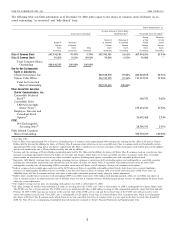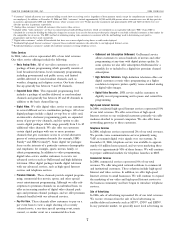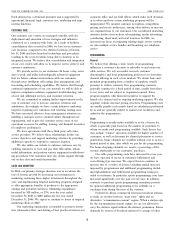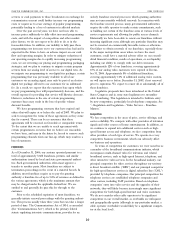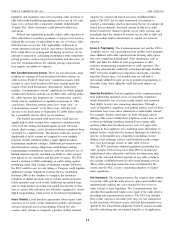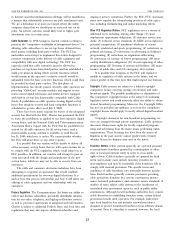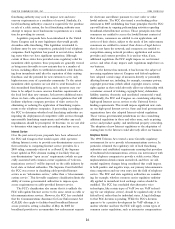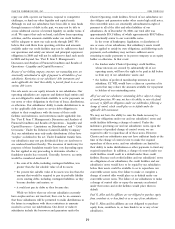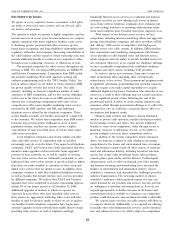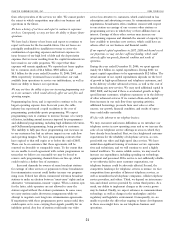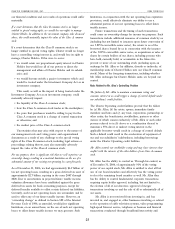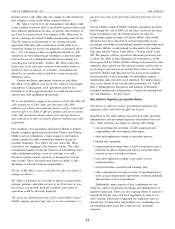Charter 2006 Annual Report Download - page 28
Download and view the complete annual report
Please find page 28 of the 2006 Charter annual report below. You can navigate through the pages in the report by either clicking on the pages listed below, or by using the keyword search tool below to find specific information within the annual report.
CHARTER COMMUNICATIONS, INC. 2006 FORM 10-K
legislative and regulatory interest in requiring cable operators to capacity for commercial leased access by unaffiliated third
offer historically bundled programming services on an `a la carte parties. The FCC has recently announced its intention to
basis, or to at least offer a separately available child-friendly conduct a rulemaking aimed at increasing the use of commercial
‘‘Family Tier.’’ Such constraints could adversely affect our leased access channels. Increased activity in this area could
operations. further burden the channel capacity of our cable systems, and
Federal rate regulations generally require cable operators to potentially limit the amount of services we are able to offer and
allow subscribers to purchase premium or pay-per-view services may necessitate further investments to expand our network
without the necessity of subscribing to any tier of service, other capacity.
than the basic service tier. The applicability of this rule in
Access to Programming. The Communications Act and the FCC’s
certain situations remains unclear, and adverse decisions by the
‘‘program access’’ rules generally prevent satellite video program-
FCC could affect our pricing and packaging of services. As we
mers affiliated with cable operators from favoring cable opera-
attempt to respond to a changing marketplace with competitive
tors over competing multichannel video distributors, such as
pricing practices, such as targeted promotions and discounts, we
DBS, and limit the ability of such programmers to offer
may face Communications Act uniform pricing requirements
exclusive programming arrangements to cable operators. The
that impede our ability to compete.
FCC has extended the exclusivity restrictions through October
Must Carry/Retransmission Consent. There are two alternative legal 2007. Given the heightened competition and media consolida-
methods for carriage of local broadcast television stations on tion that Charter faces, it is possible that we will find it
cable systems. Federal ‘‘must carry’’ regulations require cable increasingly difficult to gain access to popular programming at
systems to carry local broadcast television stations upon the favorable terms. Such difficulty could adversely impact our
request of the local broadcaster. Alternatively, federal law business.
includes ‘‘retransmission consent’’ regulations, by which popular
Ownership Restrictions. Federal regulation of the communications
commercial television stations can prohibit cable carriage unless
field traditionally included a host of ownership restrictions,
the cable operator first negotiates for ‘‘retransmission consent,’’
which limited the size of certain media entities and restricted
which may be conditioned on significant payments or other
their ability to enter into competing enterprises. Through a
concessions. Broadcast stations must elect ‘‘must carry’’ or
series of legislative, regulatory, and judicial actions, most of these
‘‘retransmission consent’’ every three years, with the next
restrictions have been either eliminated or substantially relaxed.
election to be made prior to September 15, 2008. Either option
For example, historic restrictions on local exchange carriers
has a potentially adverse effect on our business.
offering cable service within their telephone service area, as well
The burden associated with must carry could increase
as those prohibiting broadcast stations from owning cable
significantly if cable systems were required to simultaneously
systems within their broadcast service area, no longer exist.
carry both the analog and digital signals of each television
Changes in this regulatory area, including some still subject to
station (dual carriage), as the broadcast industry transitions from
judicial review, could alter the business landscape in which we
an analog to a digital format. The burden could also increase
operate, as formidable new competitors (including electric
significantly if cable systems are required to carry multiple
utilities, local exchange carriers, and broadcast/media compa-
program streams included within a single digital broadcast
nies) may increasingly choose to offer cable services.
transmission (multicast carriage). Additional government-man-
The FCC previously adopted regulations precluding any
dated broadcast carriage obligations could disrupt existing
cable operator from serving more than 30% of all domestic
programming commitments, interfere with our preferred use of
multichannel video subscribers and from devoting more than
limited channel capacity, and limit our ability to offer services
40% of the activated channel capacity of any cable system to
that appeal to our customers and generate revenues. The FCC
the carriage of affiliated national video programming services.
issued a decision in 2005 confirming an earlier ruling against
These cable ownership restrictions were invalidated by the
mandating either dual carriage or multicast carriage. However,
courts, and the FCC is now considering adoption of replace-
the FCC could reverse its own ruling or Congress could legislate
ment regulations.
additional carriage obligations. Federal law has established
February 2009 as the deadline to complete the broadcast Pole Attachments. The Communications Act requires most utilities
transition to digital spectrum and to reclaim analog spectrum. to provide cable systems with access to poles and conduits and
Cable operators may need to take additional operational steps simultaneously subjects the rates charged for this access to
and/or make further operating and capital investments at that either federal or state regulation. The Communications Act
time to ensure that customers not otherwise equipped to receive specifies that significantly higher rates apply if the cable plant is
digital programming, retain access to broadcast programming. providing telecommunications services. The FCC has clarified
that a cable operator’s favorable pole rates are not endangered
Access Channels. Local franchise agreements often require cable
by the provision of Internet access, and that determination was
operators to set aside certain channels for public, educational,
upheld by the United States Supreme Court. It remains possible
and governmental access programming. Federal law also
that the underlying pole attachment formula, or its application
requires cable systems to designate a portion of their channel
14



